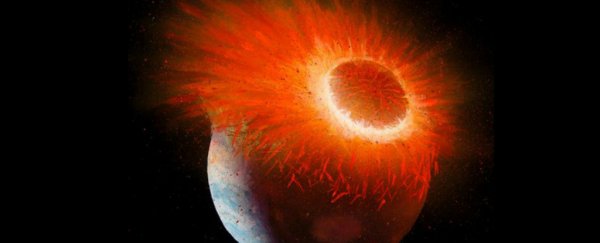Astronomers investigating how the Moon formed have found evidence that it was produced after a small planet smashed headfirst into Earth around 4.5 billion years ago. And research suggests that this collision was so violent that the 'planetary embryo' that hit us, called Theia, ended up fusing with both Earth and the Moon as a result.
The idea that the Moon was formed as part of a Solar System crash isn't new, but scientists in the past have proposed that Theia simply side-swiped Earth, blasting the Moon into orbit and then continuing off into space. Now new research by a team at the University of California, Los Angeles, suggests that Theia actually never left us.
To figure this out, the team analysed seven lunar rocks brought back to Earth by the Apollo missions, as well as six volcanic rocks from Earth's mantle.
They were looking into which oxygen isotopes the rocks contained - which means they were counting the number of protons and neutrons in oxygen atoms. That's important, because the rocks on each planetary body in our Solar System has a unique 'fingerprint' ratio of oxygen isotopes, that can be used to work out where they came from.
For instance, more than 99.9 percent of Earth's oxygen is O-16, which means each atom contains eight protons and eight neutrons. But there are also small amounts of O-17 and O-18 on Earth. And it's the ratio between O-16 and O-17 that scientists can use to work out where rocks - and other substances - have come from.
If Theia simply side-swiped Earth and produced the Moon, as previously predicted, the Moon would be made up mainly of Theia, and Earth and Moon rocks would have different oxygen isotope ratios. But this wasn't the case.
"We don't see any difference between Earth's and the Moon's oxygen isotopes; they're indistinguishable," said lead researcher Edward Young.
Instead, the findings back up a hypothesis proposed in 2012, which stated that Theia and Earth were actually involved in a head-on collision, rather than a side-swipe, and ended up fusing together as a result.
"Theia was thoroughly mixed into both the Earth and the moon, and evenly dispersed between them," said Young. "This explains why we don't see a different signature of Theia in the Moon versus Earth."
We still don't know a lot about Theia - Young and his team believe that the planetary embryo was similar in size to Earth, while others believe it was closer to Mars.
But Young explains that there's evidence Theia was growing, and if it had survived the crash, it would have become a planet in its own right.
If confirmed, the research which has been published in Science, will change our understanding of how our planet formed and evolved.
It could also provide some insight into where our water came from - a head-on collision with Theia would have most likely stripped any water from Earth. If this is the case, it may have only been brought back by small asteroid collisions tens of millions of years later.
While it's pretty sad to think about our planet wiping out another one in order to get where we are today, it's fascinating to think about all the accidents that had to come together to result in life on Earth.
